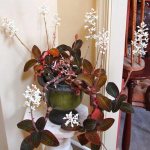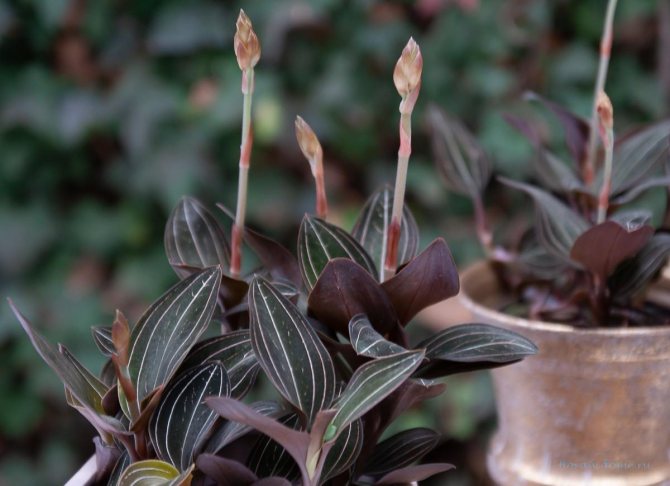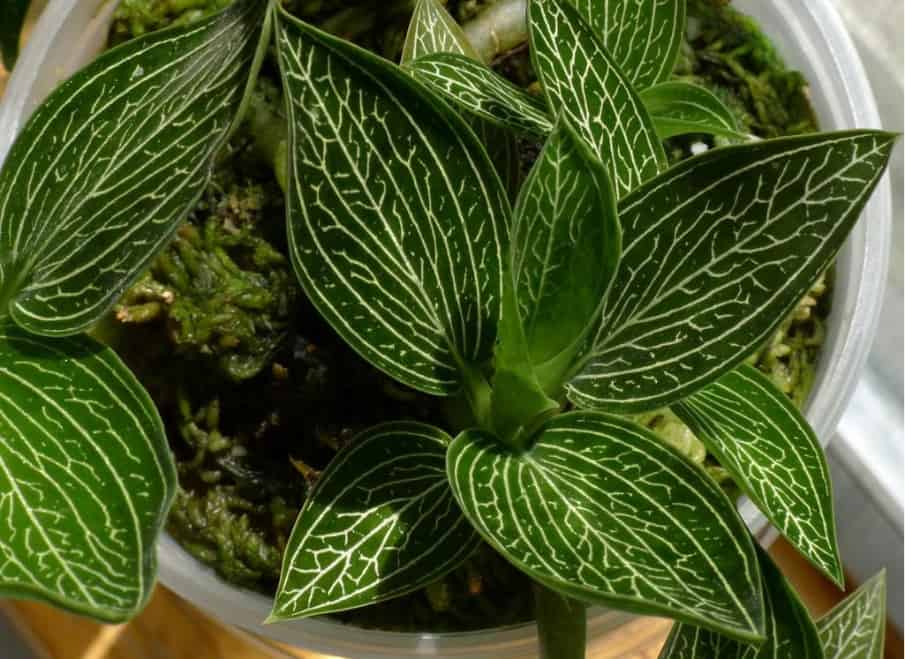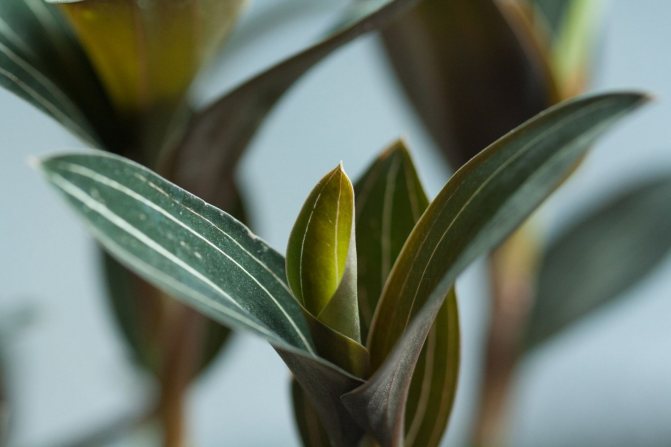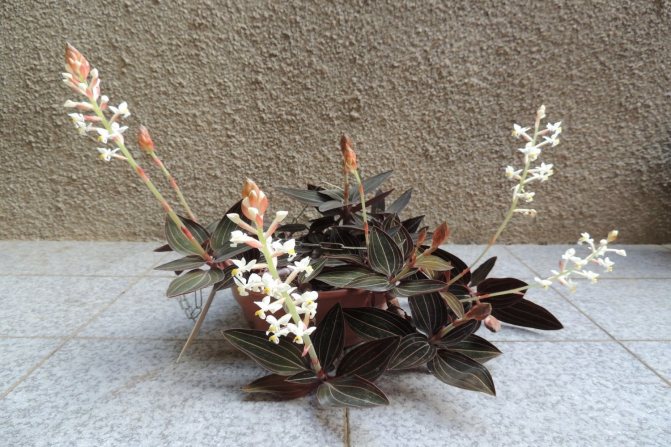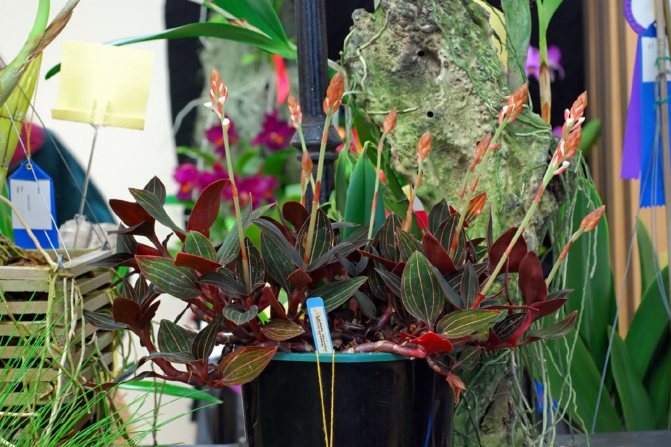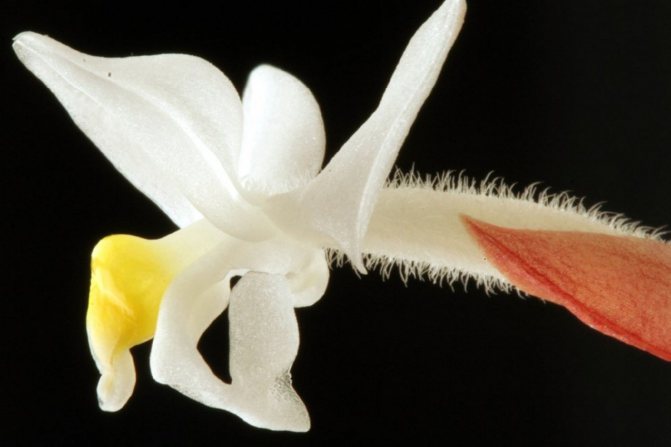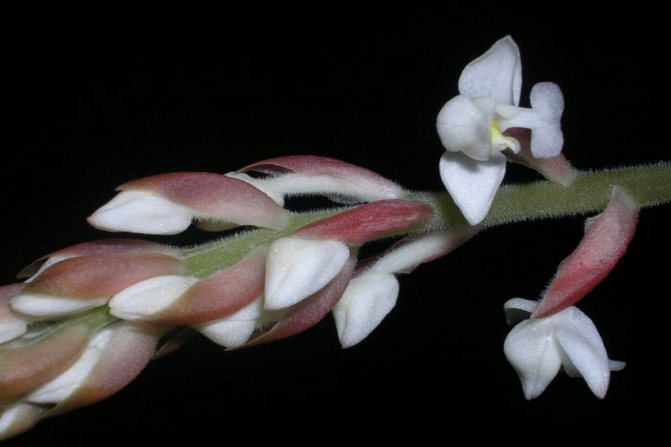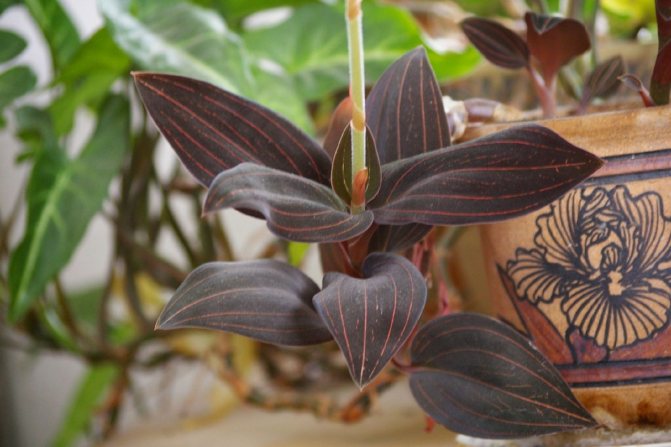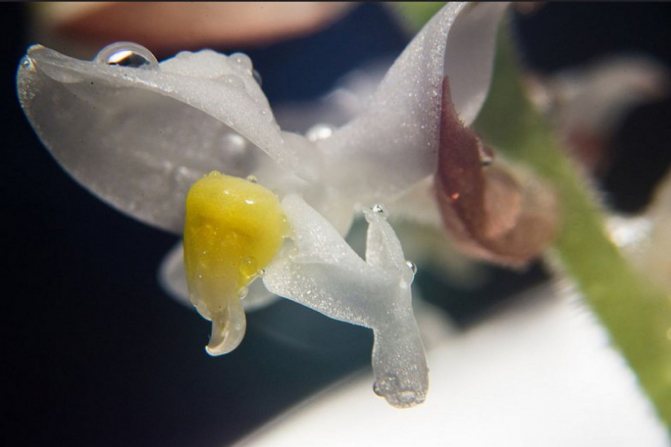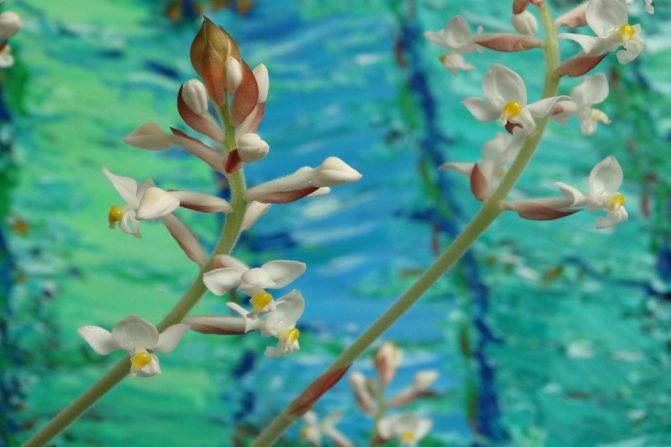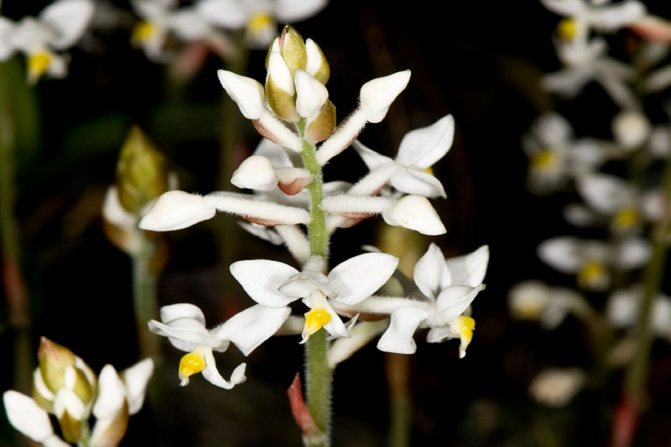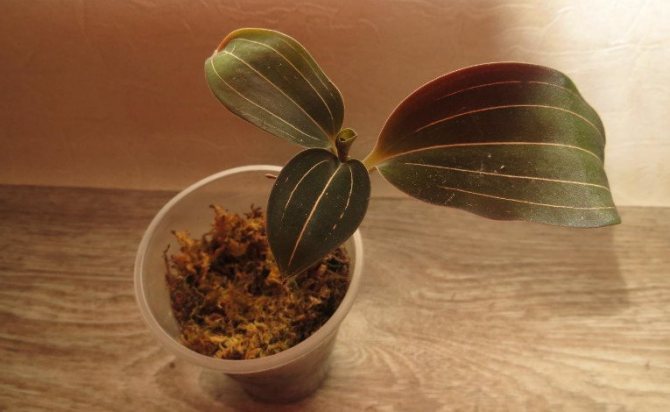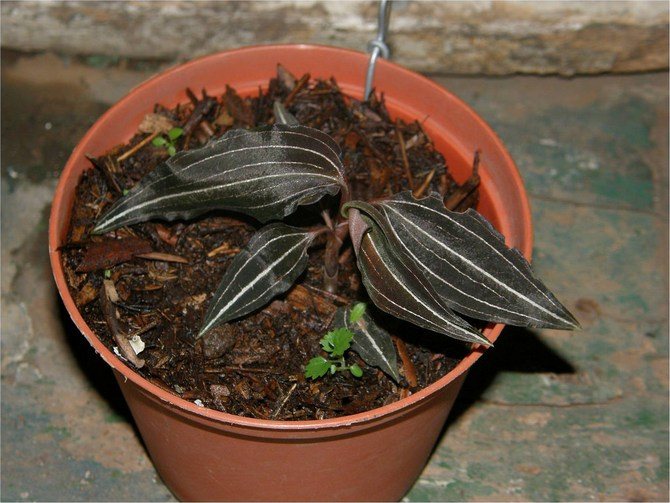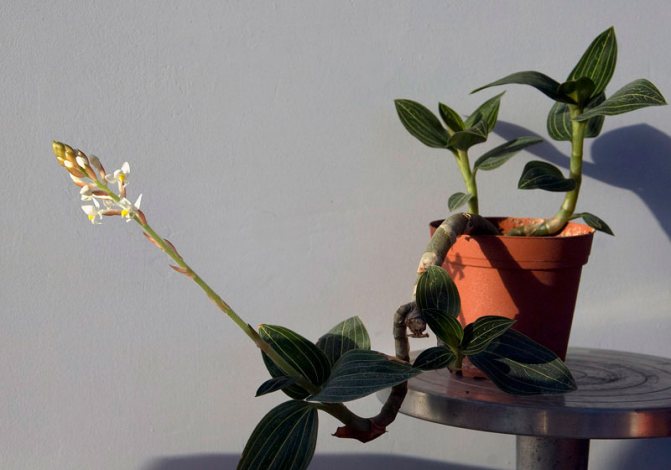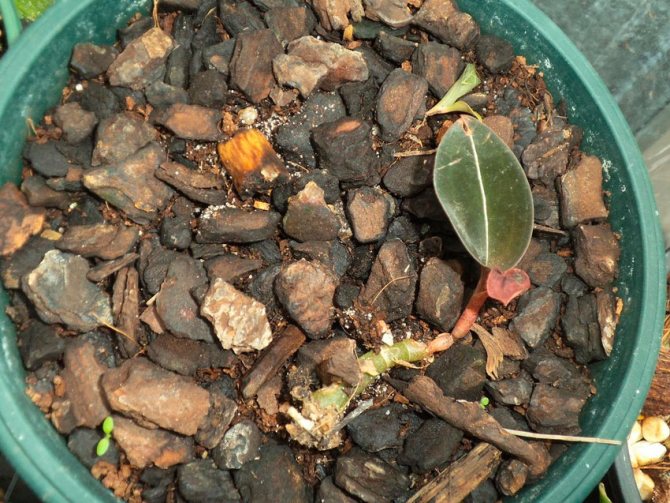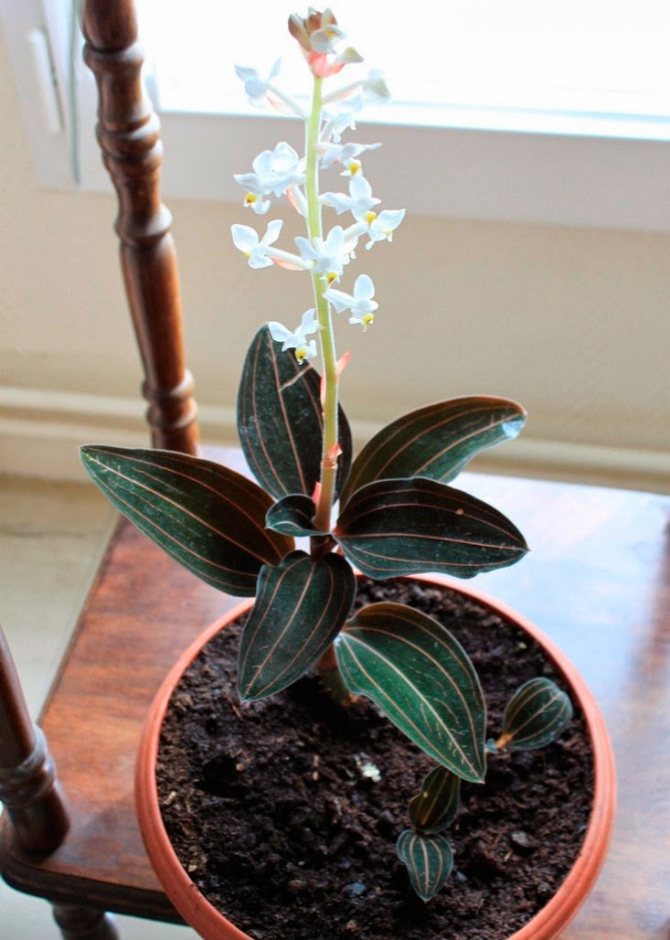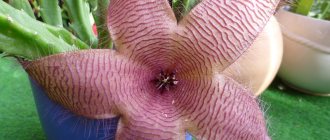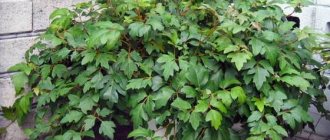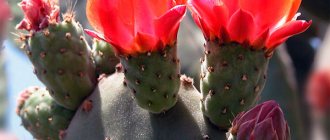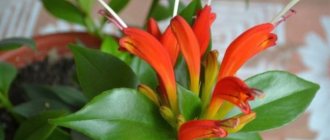Description of ludisia - precious orchid

Ludisia discolor orchid at home photo
The rhizome is short, but well branched, it does an excellent job of obtaining nutrients and fixing the plant, both on horizontal and vertical surfaces. A powerful twisting stem with rosettes of sessile leaves represents the upper part of the plant. The growth of ludisia can be only up to 15 cm, but it actively releases lateral processes, spreading in width.
- The leaves are alternate, vaginal, oval or ovoid in shape with a pointed tip. One rosette is made up of about five leaves.
- The maximum length of the leaf reaches 7 cm, in width - 4 cm. A beautiful pattern is always scattered on the surface of the leaf, the leaf plate is smooth or can be covered with a short nap, the leaf is painted bright green.
- The reverse side of the leaf is always smooth and has a darker shade. The leaf can live as much as 7 years, and withering leaves a ring-shaped mark on the stem.
Ludisia flowers are quite graceful, but do not cause much delight. Each leaf rosette produces a straight peduncle about 25 cm long. It is covered with several whitish flowers with buds up to 2 cm in diameter. The petals are rounded, white, with bright yellow stamens in the middle. Ludisia is called precious due to flowers that resemble pearl threads and leaves covered with silvery patterns. Flowering occurs from November to January and can last for about 5 weeks.
Ludisia orchid: cultivation features
The size of this evergreen sympodial plant does not exceed 15 cm.It has thick creeping stems that bear regular leaves of a velvety texture up to 7 cm long, or collected in rosettes.The leaves are colored in different ways: purple, burgundy, emerald green and even black. moreover, often the upper side of the leaves is decorated with iridescent silvery strokes and stripes, and the lower side is smooth and darker than the main tone of the upper side. Small and inconspicuous white or yellowish-white flowers are located on peduncles up to 30 cm in height in the next order in the amount of 20-30 pieces. Flowering begins in November-January and lasts about 5 weeks.
Propagation of ludisia by cuttings


Cutting ludisia photo
Ludisia orchid is propagated vegetatively. She does not have a clearly defined rest period, so reproduction can be carried out all year round. Cut the stems into cuttings with 2-3 internodes. Use a sharp, disinfected blade, treat the ends of the cut with crushed charcoal.
It is recommended to plant in a mixture of crushed pine bark and sphagnum moss. Lay the cuttings horizontally on the surface of the soil, press lightly, do not sprinkle with earth on top. Cover the container with plastic wrap or glass. Rooting will take place within 2-4 weeks. Young roots will be clearly visible along the edges of the cutting.
With the appearance of the first leaves, gradually accustom the orchid to the lack of shelter, while the air humidity should be high. If flower stalks appear on young seedlings, remove them immediately so as not to burden the plant at the stage of rooting and growth.
Subsorts and varieties
Ludisia orchid has several varieties and sub-varieties.
Dawsoniana
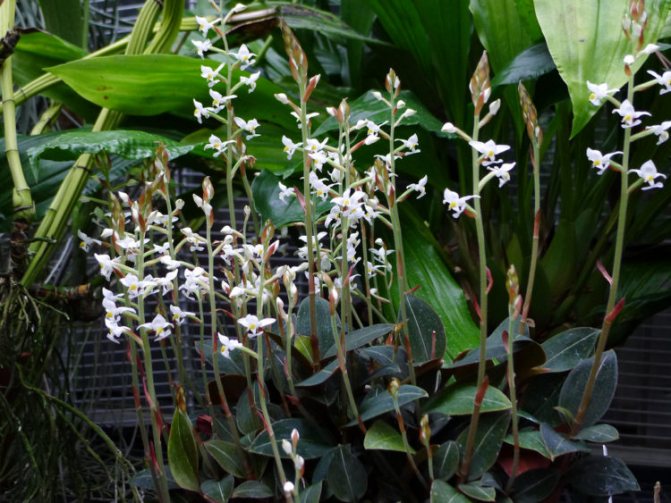

The largest form. Height 30 centimeters. The leaves are red with pink veins..
Watch a video about the features of Ludisia Dawson:
Odina
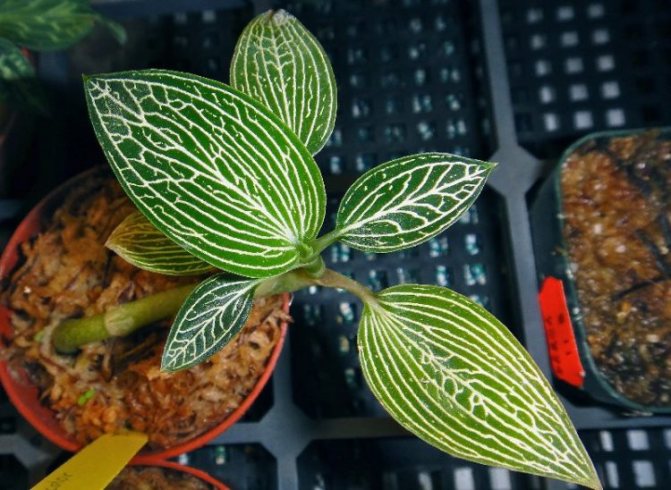

The leaves of the plant range in color from green to black with silvery veins.
Sapfir velvet


Unpretentious plant. suitable for growing even for novice growers. This variety has velvety foliage ranging from light green to dark brown. On its leaves veins of silver, bronze and even gold color, which is why this orchid has a second name - precious.
Watch a video about the features of Ludisia Sapphire Corduroy:
Ludisia care at home
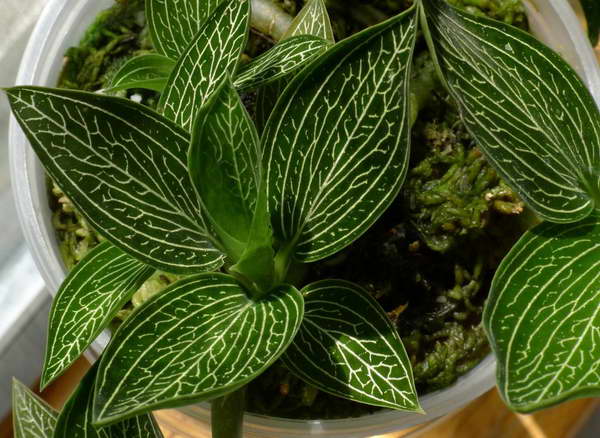

Growing ludisia at home photo
Planting ludisia
Taking care of such a beautiful plant will require some effort and reverent handling. Adult orchids are planted in small transparent pots with large drainage holes. Be sure to place vermiculite or brick chips on the bottom, and pour the desired soil on top. What soil should you plant? This can be a ready-made orchid soil purchased from a flower shop.
The soil mixture prepared for ludisia on its own should contain:
- 4 parts chopped pine bark with needles
- 4 parts sphagnum moss pieces
- 1 part of charcoal, peat and sheet earth.
For those who do not want to prepare the earth on their own, it is recommended to purchase ordinary soil for orchids and plant a plant in it.
The root is placed in the upper layers of the soil; the growth buds do not need to be buried. There is no need for frequent replanting of the flower. This has to be done as the roots grow, about once every 3-4 years.
Location
For ludisia, a place in the shade is preferable, but is able to withstand the morning or evening rays of the sun. It will grow well even on northern windowsills; it is advisable to provide additional lighting in winter. Long daylight hours are a favorable flowering factor.
Air temperature
The temperature should be moderately warm. 20-23 ° C will be sufficient, and the night coolness of about 17-19 ° C will be beneficial, stimulating an abundance of flowering.
To create such conditions, it will be most convenient to put the pot on the balcony or terrace for the period from May to September. Protect the flower from drafts.
Watering and humidity
Watering should be regular throughout the year. The soil should be kept moist at all times, but without stagnation of water. Drain excess liquid from the pallet 30 minutes after watering.
Moist air is required. Use the following moisturizing methods: you can put the plant near a fountain, an aquarium; place periodically in a tray of wet vermiculite and pebbles; use a humidifier.
Do not spray a precious orchid to avoid water stains.
Top dressing, diseases and pests
If the transplant is regular, the plant will not need feeding, it will receive all the necessary substances from the nutrient soil. Only at the flowering stage is it recommended to apply half of the complex of minerals for orchids twice a month.
Proper care will prevent disease from occurring. Lush foliage attracts parasites - scale insects, aphids, whiteflies, mealybugs. To save the precious beauty, insecticide treatment will help immediately when the first signs of an invasion appear.
Pruning ludisia
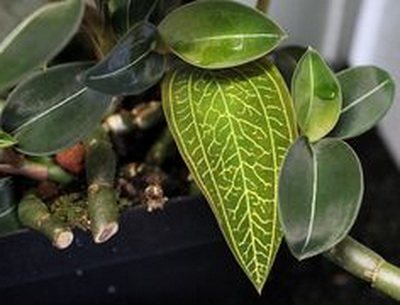

How to prune a ludisia precious orchid
Over time, the shoots of the precious orchid stretch out, losing their attractiveness and exposing themselves from below. To return the bush to a compact, lush appearance, the shoots are radically cut off almost at the root, leaving hemp of 4-5 cm. Soon the plant will release new shoots with thick leaves, the crown will acquire an elegant look.
Diseases and pests of ludisia
At home, the ludisia orchid is affected by whiteflies, scale insects, mealybugs and spider mites.
The spider mite sucks the juices out of the plant, making punctures in the leaves of the plant. Pests greatly weaken the orchid.It is almost impossible to see tiny mites, but if you notice a thinnest cobweb on a flower, and discolored dots on the leaves, it means that spider mites parasitize on the orchid. They start up in conditions of insufficient air humidity, which is contraindicated for ludisia. Since ticks are not insects, but arachnids, they are destroyed not with insecticides, but with acaricidal preparations - Apollo, Aktofit, Vertimek, Aktellik or Fitoverm.
Scabbards are small insects covered with a wax shell. They also belong to sucking pests that slow down the development of the plant. In addition, their secretions attract sooty fungus, which covers the ground parts of the plant with a black bloom, which does not add to the precious ludisia attractiveness. In the fight against scale insects, neem oil is used, abundantly lubricating the places of accumulation of larvae and adults with it, after which they are removed from the plant mechanically. Then the orchid is treated with a solution of the drug Tanrek, Colorado, Mospilan, Actellik, Confidor, Aktara, Karbofoss or some other insecticide.
- Lavender: planting and care in the open field, types and varieties
Mealybugs are white lumps on the leaves that resemble pieces of cotton wool sprinkled with flour. They are easy to spot and recognize. To destroy the worms, ludisia is treated with Agravertin, Fitoverm, Aktellik, Akarin or Neoron, but first you need to remove the worms from the orchid with a cotton swab moistened with soapy water or alcohol.
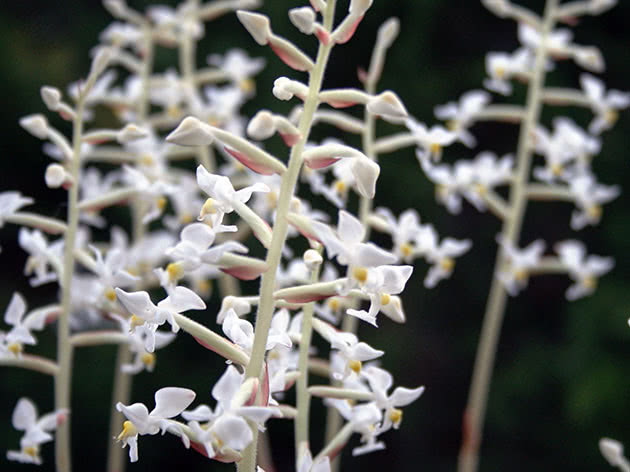

Whiteflies are small white moths with waxy bloom on their wings. They settle on the underside of leaves and lay their eggs there. If you lightly shake a plant infested with whiteflies, they will immediately fly up into a white cloud. A sign of the presence of whiteflies on the plant is shiny traces on the upper side of the leaves - this is honeydew, or honeydew, pest waste, on which a sooty fungus develops over time, covering the surface of the leaves first with white and then black bloom. To combat whiteflies, the same drugs are used as for the destruction of worms.
Transplanting and dividing the ludisia bush at home


How to split a precious orchid bush photo
It is necessary to transplant a precious orchid once every 2-3 years. During this time, the bush grows well and requires division. This procedure rejuvenates the plant and produces additional seedlings that will decorate the apartment.
To divide the bush, it is watered and allowed to dampen the earth. Then they carefully remove the pot from the earthen coma and try to divide the shoots with the roots into parts without damaging the small roots. The resulting cuttings are planted in a pot with prepared soil and drainage arranged at the bottom.
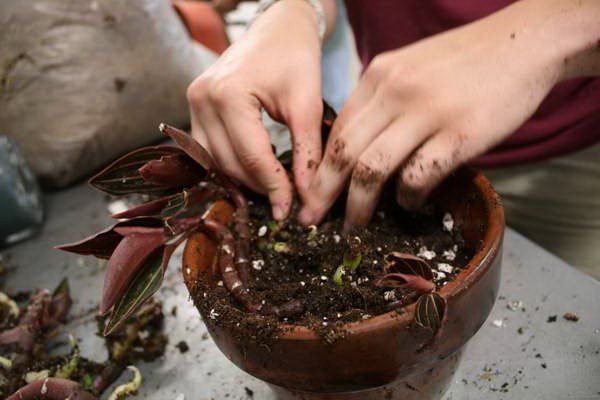

How to transplant ludisia photo
The root system of the plant is underdeveloped, superficial, with powerful central roots. They try to lay out the shoots in the same way as they grew before transplanting.
Diseases of ludisia
Root rot affects the orchid with a constantly moist substrate. The disease begins from the roots, they acquire a black tint. Unfortunately, the disease becomes noticeable already at an advanced stage, when all the leaves turn yellow and fall off.
If blackened roots are found during transplantation, they are cut off and the remainder is washed in a pink solution of potassium permanganate (sold in pharmacies). Then the flower is planted in completely new soil and not watered for several days.
Orchid branches amazes stem rotespecially when water droplets systematically run down the base of the leaves. Small areas can be cut off and the affected areas can be treated with charcoal powder. If more of the plant is affected, it is easier to root the apical cuttings.
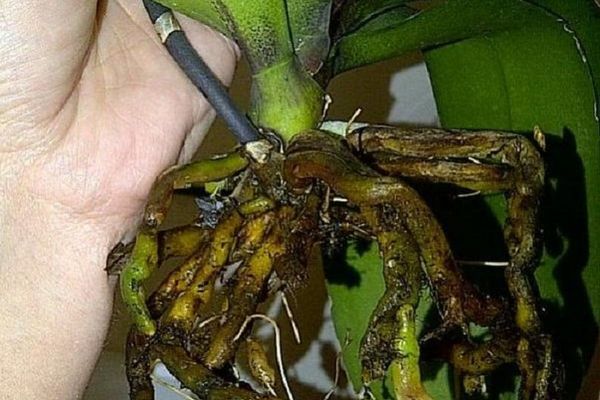

Harmful insects are often found on the orchid:
- The spider mite manifests itself as thin filaments of cobwebs on foliage, actively developing only in conditions of low air humidity.
- Mealybug looks like a viscous white coating on the stems and the surface of the ground.
- The scabbard develops in the form of dense brown growths on the leaves and branches.
Pest control is reduced to spraying the plant with insecticidal preparations, for example "Fitoverm" or "Aktara". At least three treatments with an interval of 7-10 days are considered effective.
When does ludisia bloom?
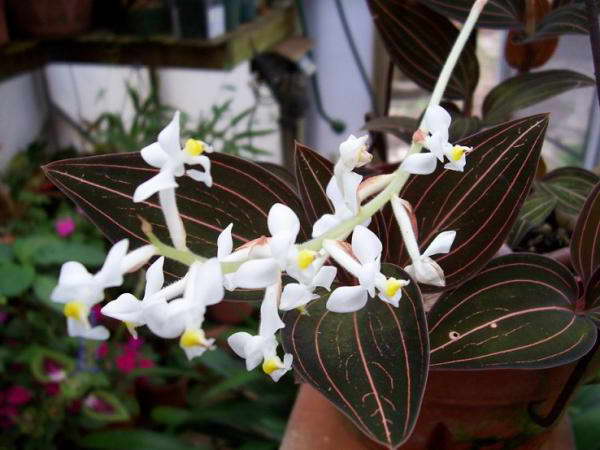

How ludisia blooms photo
The flowering period of the precious orchid is the end of autumn - the beginning of winter. At a time when all the plants go to rest, the beauty presents with the extraordinary beauty of her flowering, which can be admired for about a month.
At this time, you need to be especially careful so that water does not get on the peduncles, make sure that the soil is damp, but not waterlogged.
Description
By its nature, hemaria is a herbaceous plant that has creeping shoots on the surface of the soil. Shoot length, can reach 15 cm.
The color of the flower can vary from light burgundy to emerald, and sometimes black. The leaf of the plant lives for about 7 years, after which it dies off.
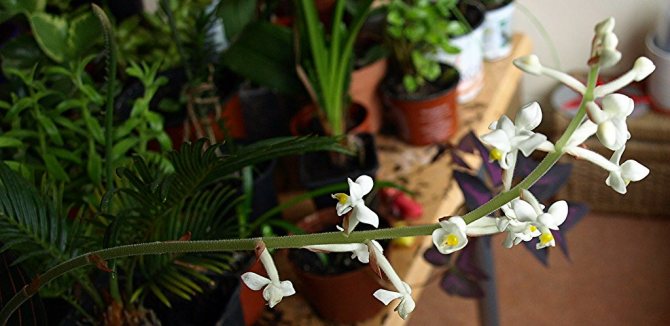

Many fans of these plants call them "Precious Orchid", the main value of the plant lies in the appearance of the plant, as well as its color. Orchid blooms often in late autumn, less often in early winter, the flowering period on average lasts about a month.
Why do the leaves of the ludisia orchid turn red?
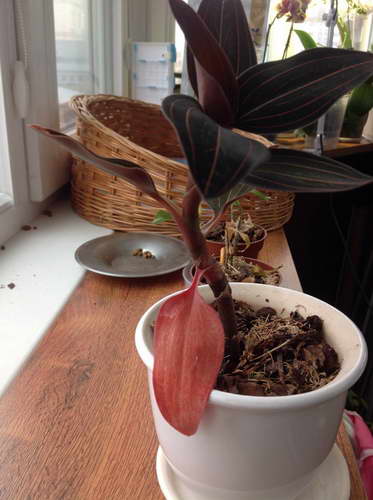

Ludisia orchid blush leaves photo
If the lower leaves of a precious orchid turn red, and then die off, then you are watering it too generously. It is necessary to reduce watering. Do not worry, after a while a new one will appear in the place of the fallen off sheet.
Sometimes the effect of reddening of the leaves is observed in old bushes, which means it is time to transplant and rejuvenate them.
Precious orchid ludisia transplant. Table: Seasonal growing conditions
| Season | Temperature | Lighting | Humidity |
| Spring | The precious Ludisia orchid in nature is capable of withstanding a wide temperature range - from 10 to 39 ° C. The innate hardening of the flower makes it possible to successfully grow it both in cool conditions and in hot ones. But in order to create the most comfortable atmosphere for the orchid, it is necessary to maintain the temperature around 25 ° C in the summer. At night, this figure should be about 3-4 ° С. | Ludisia prefers partial shade or diffused light. Sunlight, especially during the midday period, is definitely not good for the plant. But the sun's rays in the morning or evening hours are quite acceptable. Usually Ludisia is placed in the back of the room or near the windows of the west and north direction. If the orchid is grown under artificial light, then the duration of the lighting is brought to 12-14 hours per day. | Ludisia can tolerate dry air, but you shouldn't torture her. To maintain the decorative qualities of the orchid, it is best to provide a sufficiently high humidity - 70%. If you do not have a special humidifier, you can spray the orchid and the air around it, cover the pot with wet moss, or place it on a tray with a damp filler. Ludisia will feel very well near her home fountain. You will have to try especially in the summer heat and with the heaters turned on. During a period of active growth, you can remind Ludisia of warm tropical rains by placing her under a warm shower (no higher than 35 ° C). After the end of the procedure, you should lightly blot the leaves with a napkin and let them dry. Varieties with velvet leaves require increased attention in terms of spraying. Water can leave whitish streaks on the leaves. Spraying is done only with boiled or distilled water. Very good rain or melt. |
| Summer | |||
| Fall | The temperature for winter keeping is lower - about 18 ° C. The limit is a threshold of 14 ° C, a lower indicator may cause the death of Ludisia. | It is advisable to supplement the plant in winter using phytolamps or ordinary daylighting devices. |
Types and varieties of ludisia with photos and names
Ludisia discolor Ludisia discolor
Nature created only ludisia discolor (multicolor or colorless).The plant has a twisting creeping stem. The basal rosette consists of dark green leaves covered with silvery longitudinal veins. At the same time grows on the orchid 3-6 leaves. Erect peduncle 10-20 cm long, covered with a dozen small white flowers. The lower petals have a slightly oblique lip, with a long yellow anther protruding above it.
For a change, breeders have bred several decorative varieties:
Ludisia Dawson Ludisia discolor var. dawsoniana
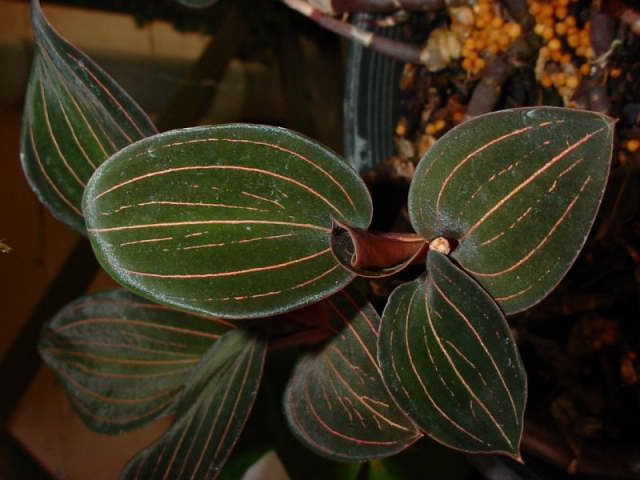

Ludisia Dawson Ludisia discolor var. dawsoniana photo
The plant, reaching a height of up to 30 cm, has larger leaves, decorated with thin stripes of a pinkish hue. The velvety surface of the leaves fascinates the eye with the richness of colors.
Ludisia Odina - longitudinal silvery veins create a pattern, there are paired transverse strokes running along the entire length of the central strip.
Ludisia alba Ludisia alba
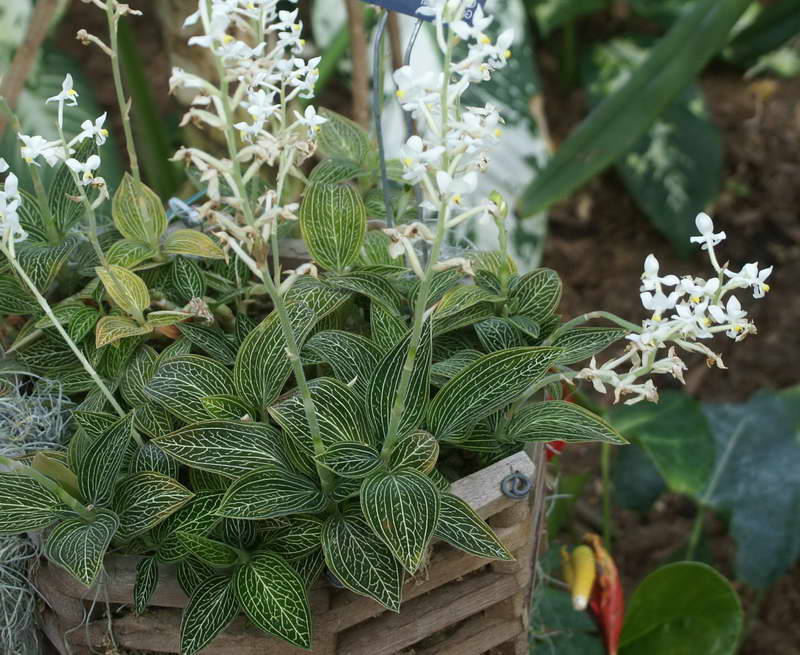

Ludisia alba Ludisia alba photo
The foliage is lighter in color with longitudinal white stripes.
Ludisia Otletae - Dark green foliage is covered with bright orange or red stripes.
Ludisia Tanlaniana


Ludisia Tanlaniana photo
The leaf plate is wider, has a light patterned mesh in the middle between the longitudinal veins.
Ludisia velvet ludisia red velvet
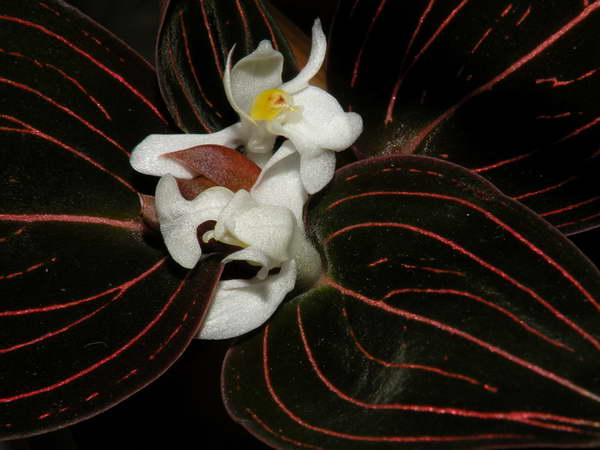

Ludisia velvet ludisia red velvet photo
The foliage is deep green with a velvety finish. The upper part of the foliage plate is decorated with longitudinal stripes.
Ludisia emerald Ludisia discolor 'Emerald Velvet'
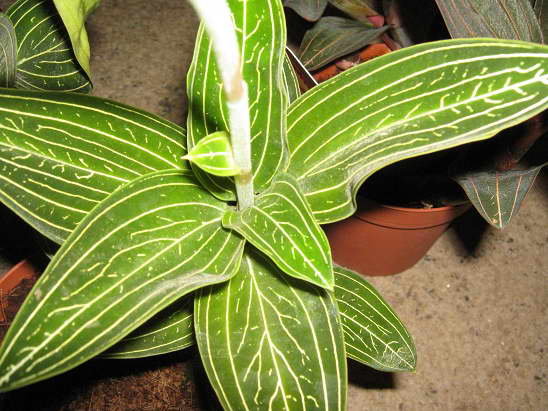

Ludisia emerald Ludisia discolor 'Emerald Velvet' photo
Choose ludisia to your taste, especially since the breeders do not stop there.
Genus and species of precious orchids grown in indoor culture
In the genus Anoectochilus, there are 43 species of small plants up to 15 cm tall with glossy green-brownish leaves covered with a pattern resembling cracks, sometimes so thick that they almost completely hide the main background of the leaf plate. Peduncles are disproportionately high in relation to the outlet, bearing a lush racemose inflorescence of unattractive small flowers. Species with especially beautiful foliage, extremely popular with flower growers:
- Sikkim (sikkimensis);
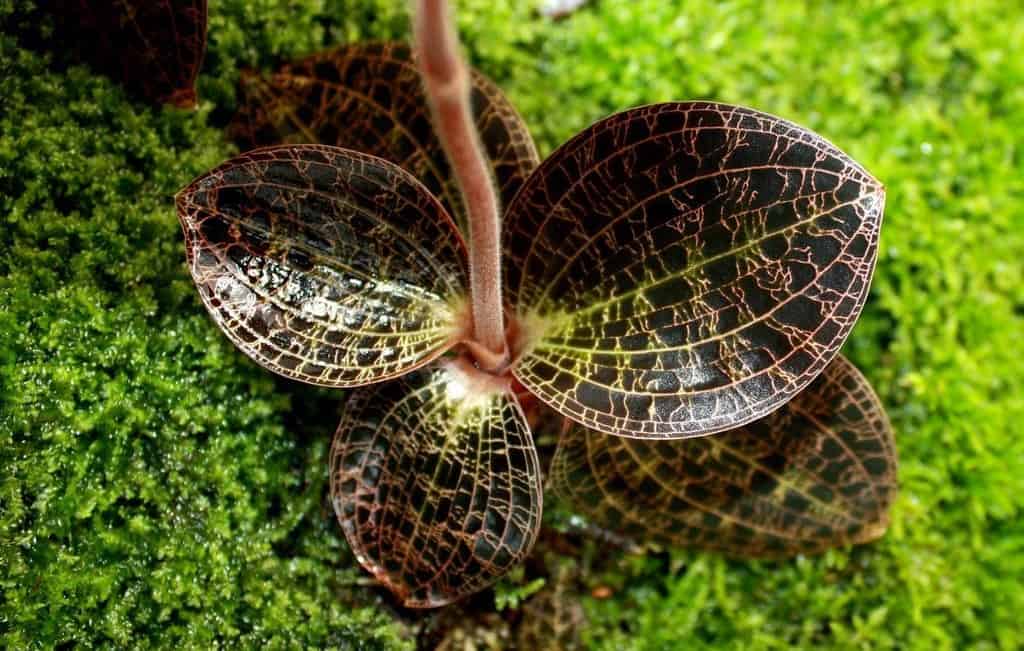

- striped (vittata);
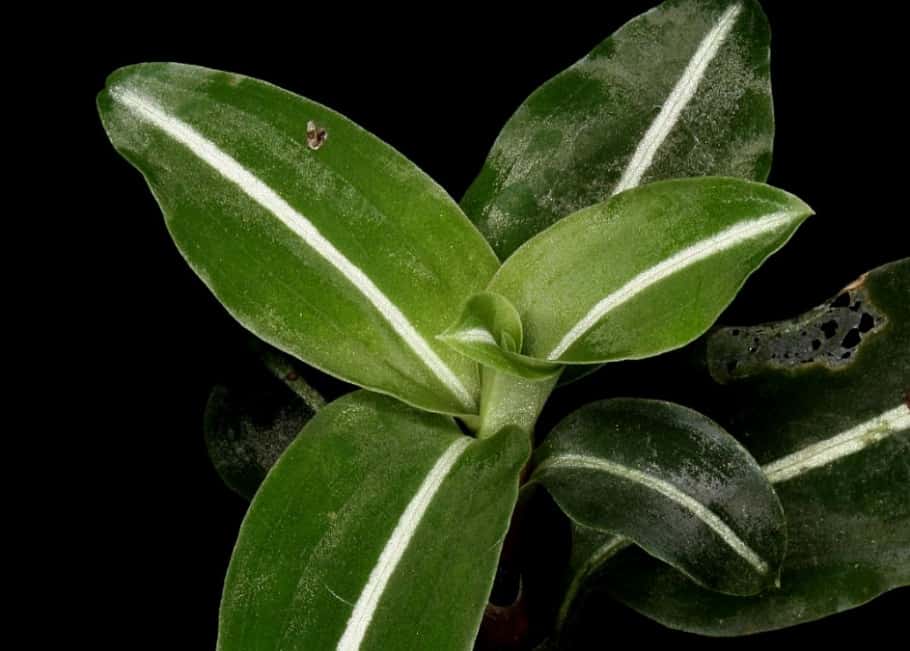

- Roxburgh (roxburghii);
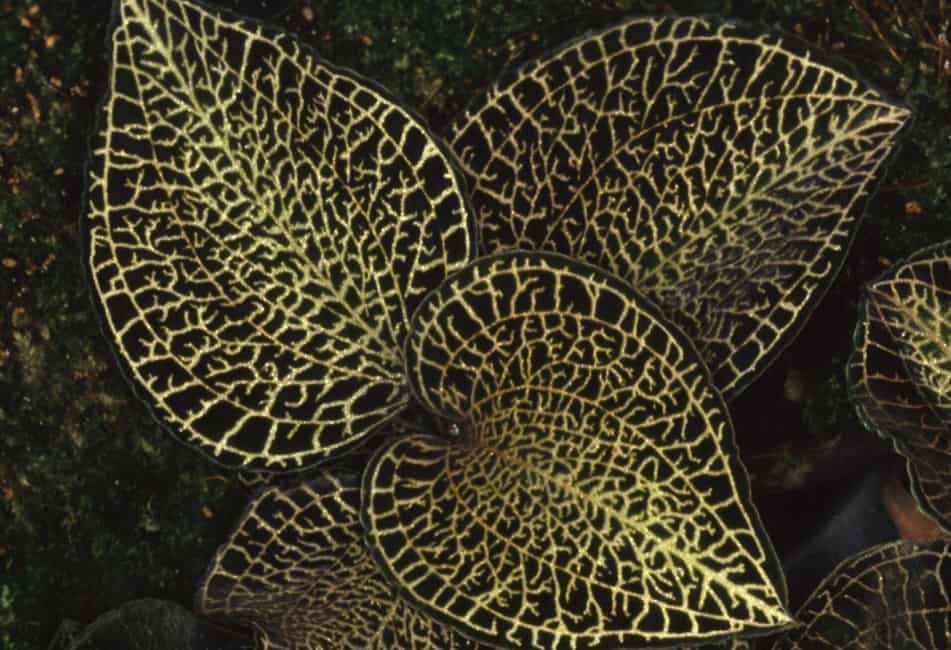

- beautiful (formosanus).
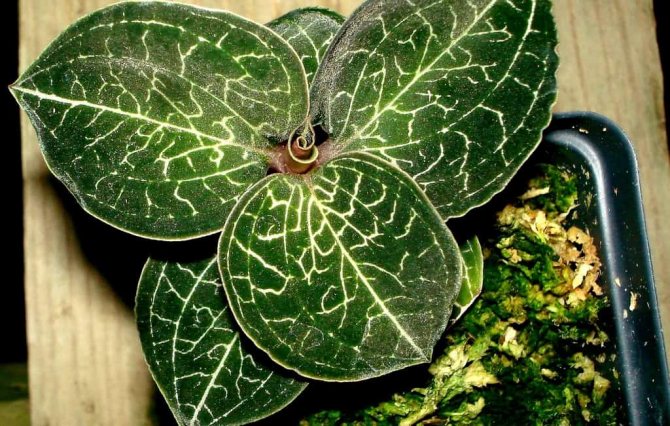

Orchids of the genus Ludisia are considered to be the most famous indoor "jewels", consisting of the only type of Ludisia discolor, or multi-colored (Ludisia discolor), incredibly diverse in colors and patterns on the leaf plates. The main form is massively distributed in the natural conditions of Southeast Asia and has ovoid leaves, pointed at the top, saturated bright green color.
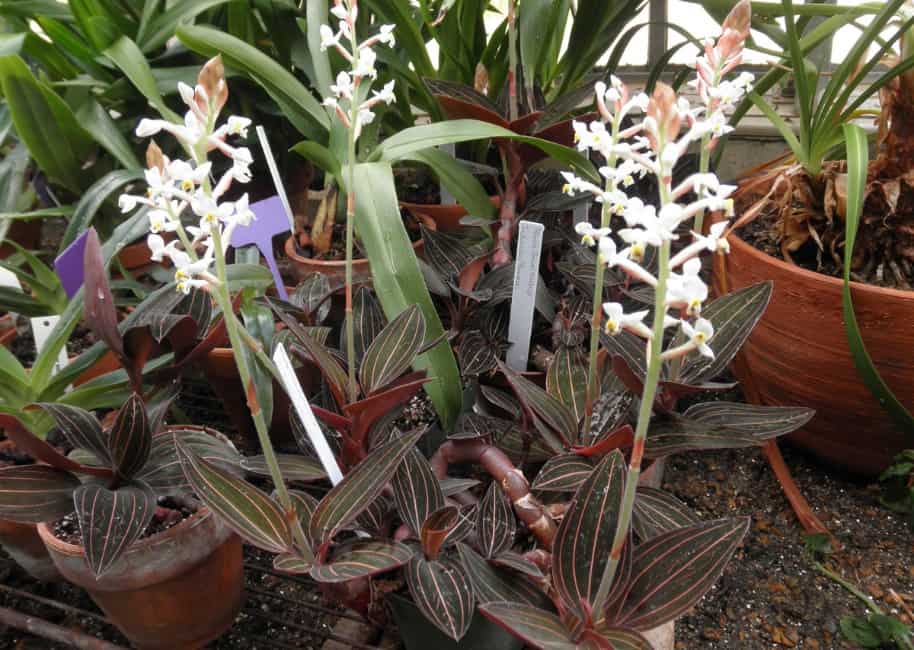

Ludisia discolor
To the touch, the leaves seem to be velor, covered with thin silvery veins - only one longitudinal or with branches. It blooms with small fragrant flowers, collected in a small inflorescence. Ludisia precious is especially beloved among Orchievods, in particular, its forms are popular:
- Dawsoniana - with cherry and chocolate leaves decorated with a pinkish mesh pattern;
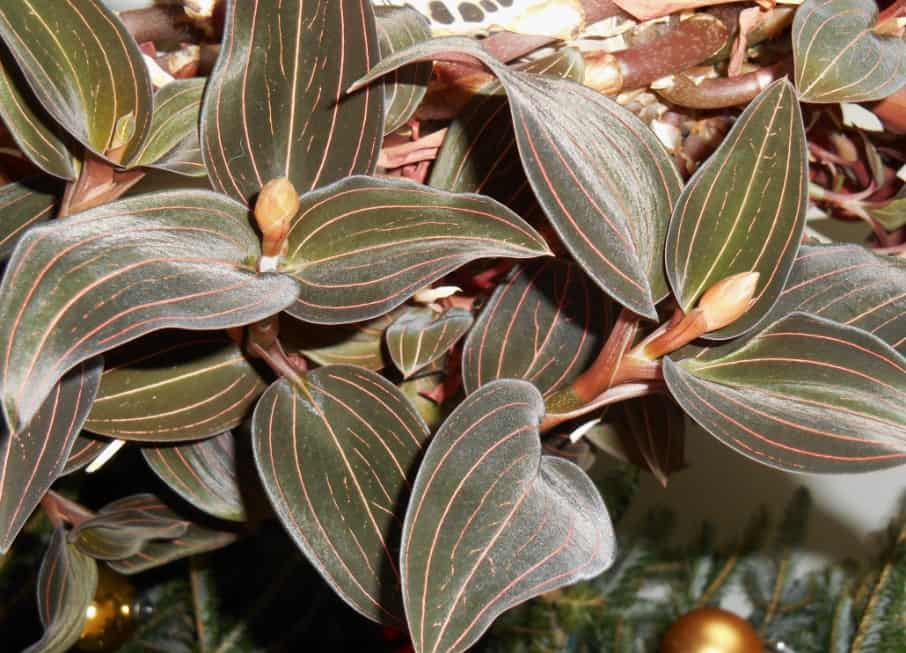

- Alba - with a snow-white pattern;
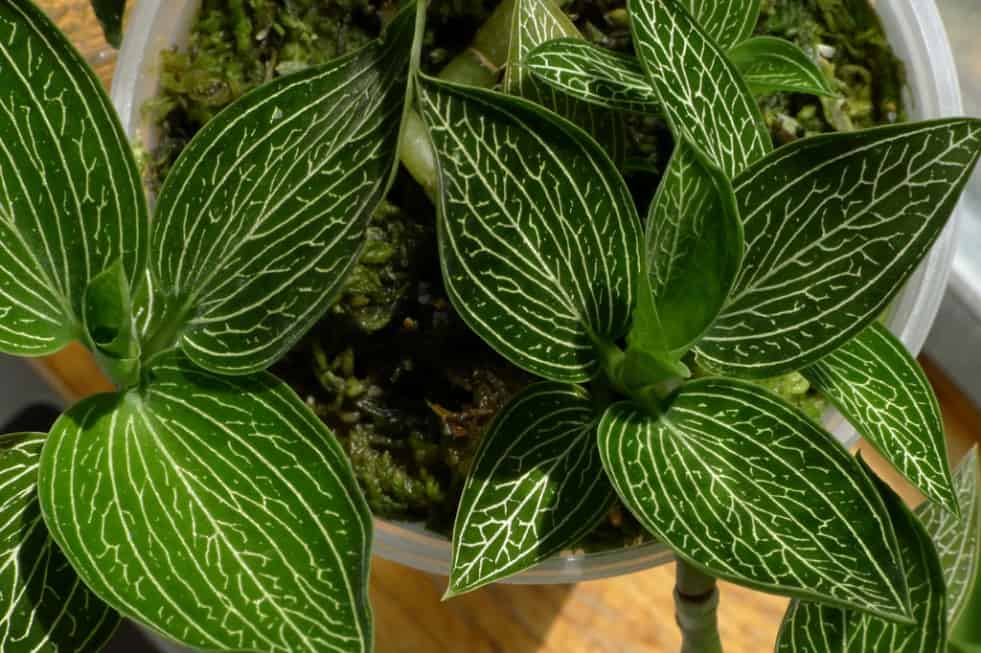

- Odina - with black and gray leaves.
And also a whole series of varieties united by the general name Velvet with dark green leaves, emerald, gray-gray, pale bluish, marsh with purple-crimson or silver veins: Green, Emerald, Jade, Sapphire, Red, Silver, Jasper.
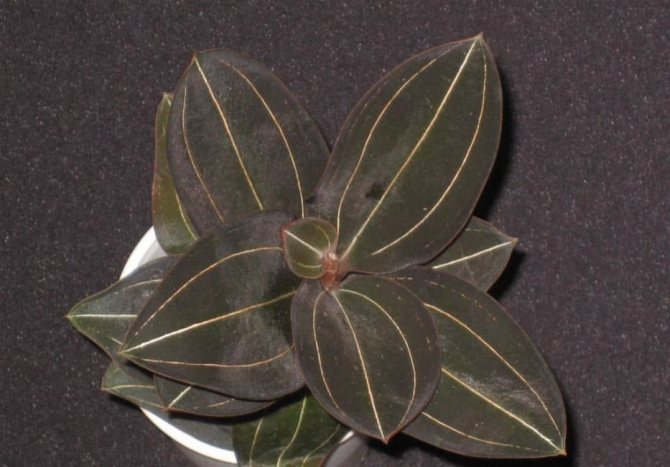

Velvet Silver
One of the genus most preferred by flower growers is the precious Macodes orchids, which include 10 species of terrestrial or epiphytic orchids with a 5–7 cm high shoot creeping along the soil surface and ideally oval variegated leaves covered with delicate pubescence. Indoor cultivation is represented by interesting species:
- Sandera (sanderiana) - larger than the previous species with spectacular veins of a copper shade on the leaves, reaching 15 cm in length;
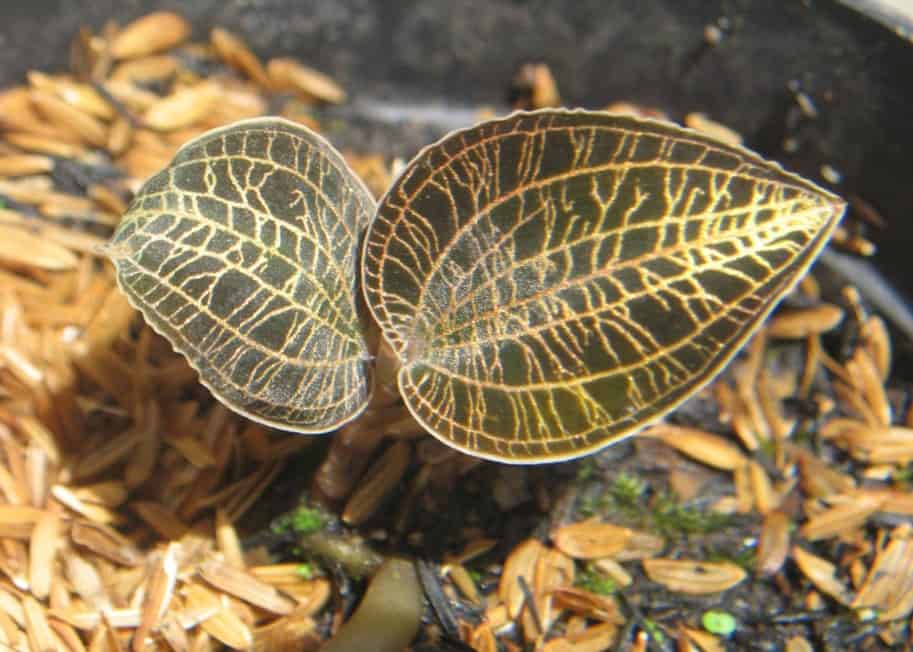

Macodes sanderiana
- Petola (petola) - with a background color of leaf plates of emerald, pale green, juicy green, grayish color with a pattern of silvery or golden veining lines. By autumn, it forms a tall peduncle with nondescript white-chocolate flowers, forming a numerous cluster of 20 buds. After the end of flowering, the rosette dies off, forming a young lateral shoot.


Macodes petola
- Goodyera - the genus that gave the name to the subtribe "precious", includes almost 100 species common in temperate and subtropical zones of the entire planet. In home collections, several species are grown with spectacular leaves of various shades of green, speckled with whitish pink, occasionally with sky-blue lace veins.
The most popular types:
- mesh (reticulata);
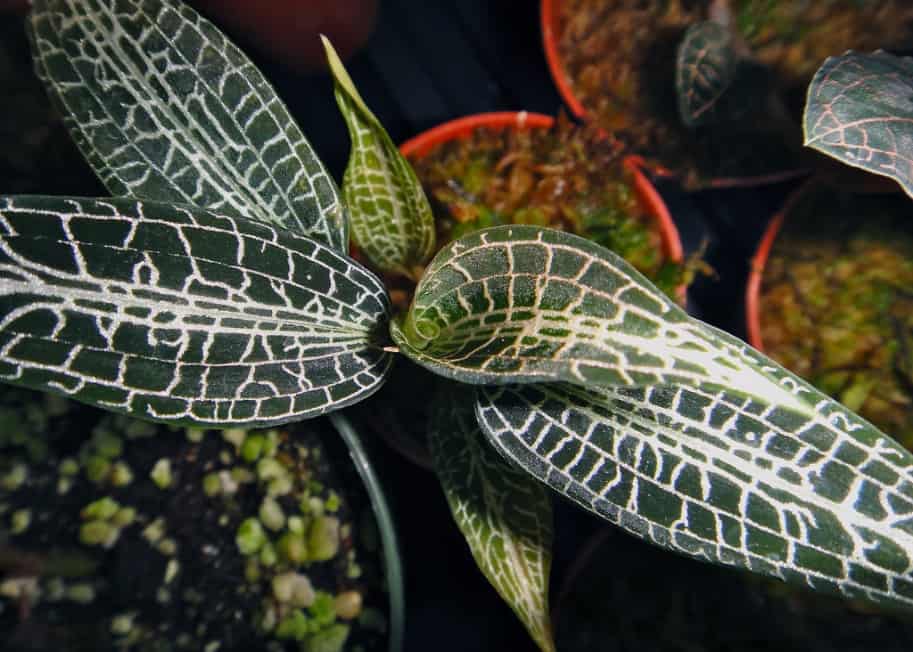

- creeping (repens);
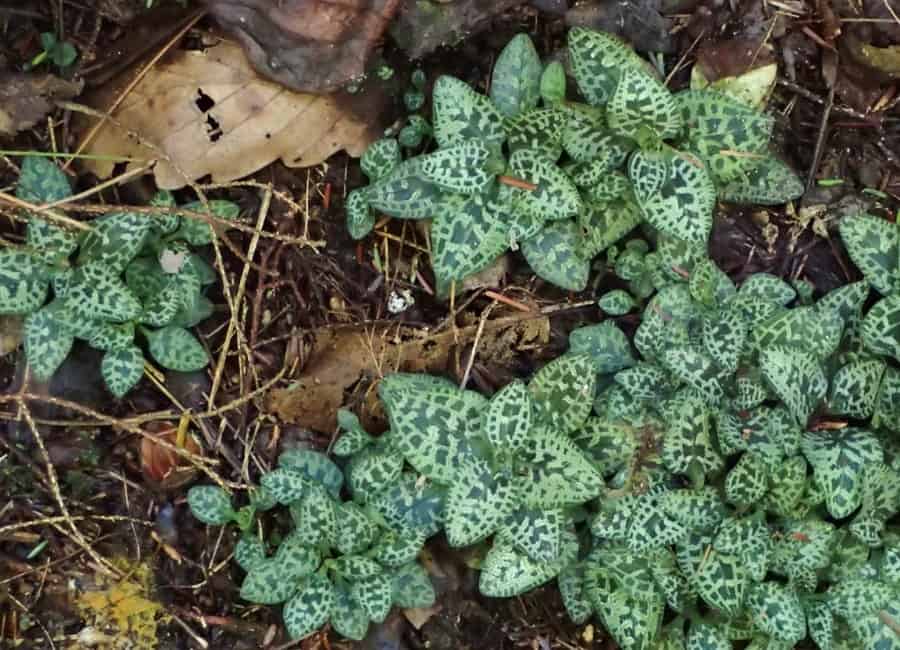

- bristly, or hispida;
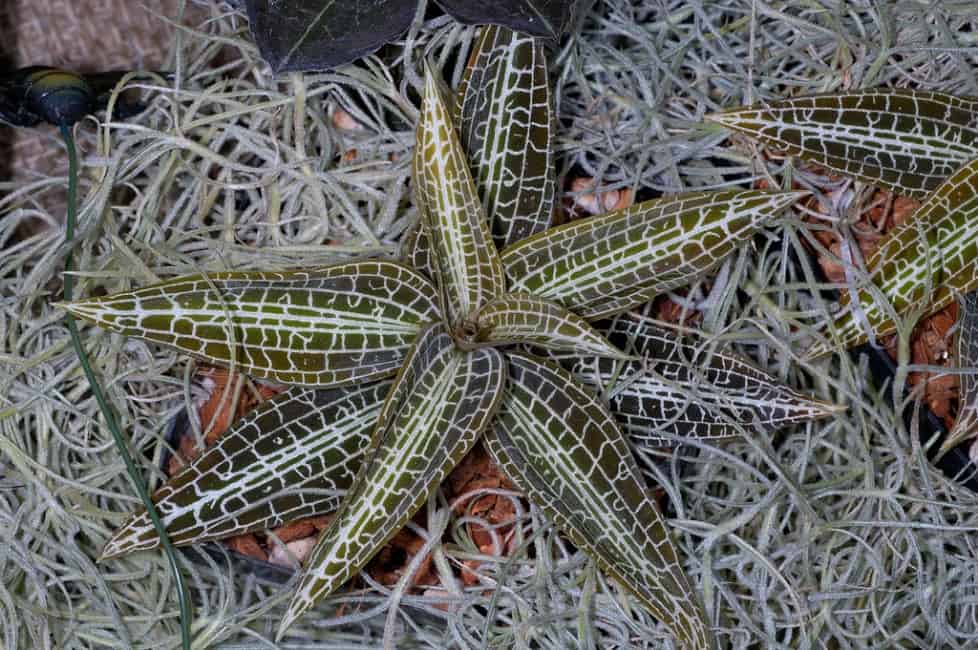

- fluffy (pubescens).
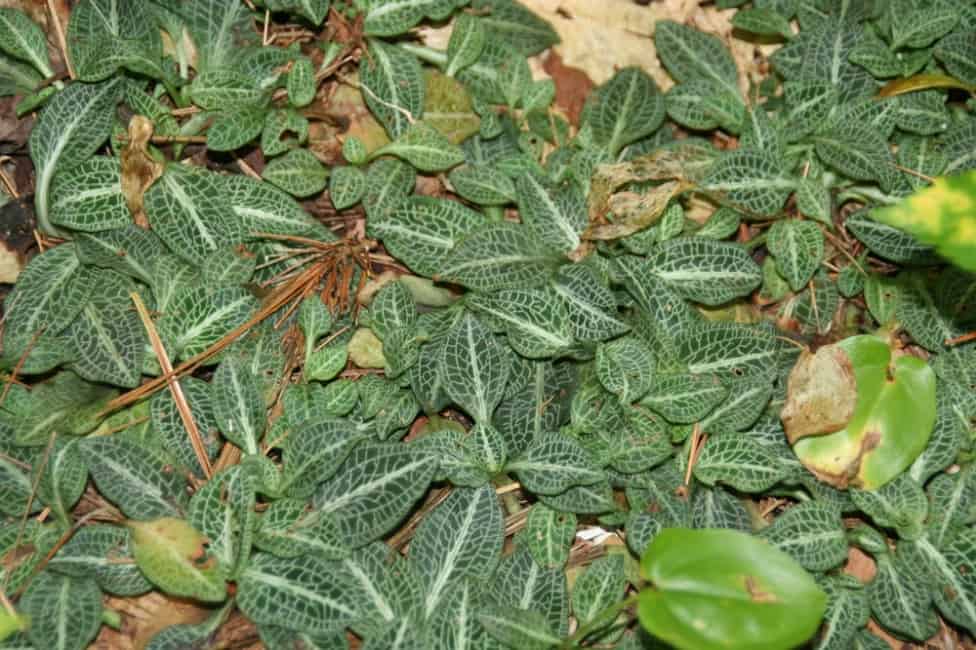

Dossinia (dossinia) is another genus of precious orchids larger than makodes, represented by one species, endemic to Borneo, - dossinia marble (marmorata), which differs from its congeners by larger than others, expressive leaves with weakly distinct veins.
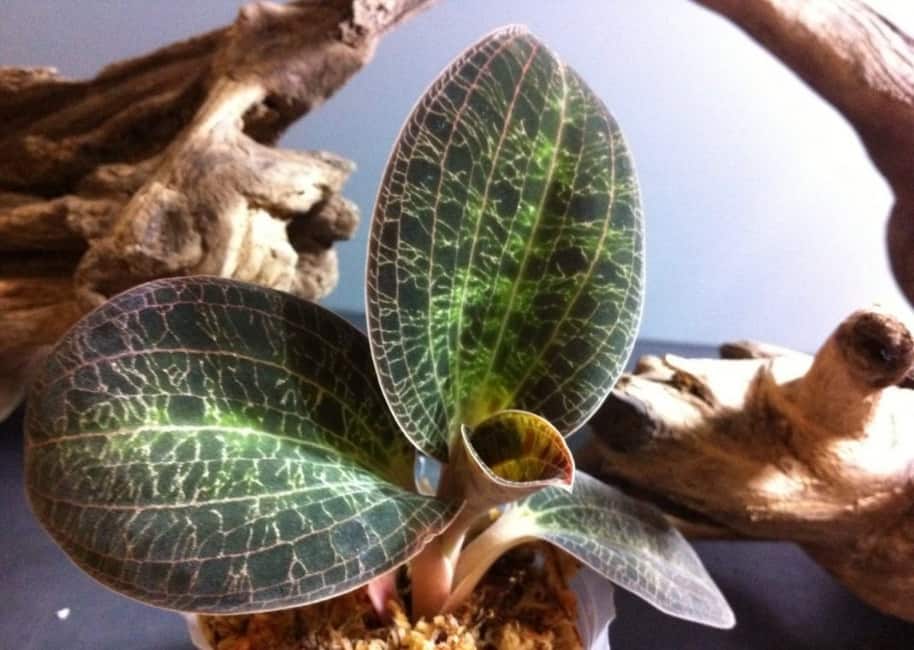

The genus Erythrodes (Erythrodes), consisting of 26 species of orchids that live in nature in Southeast Asia, China, New Guinea and some Pacific islands, is not very common in indoor keeping.
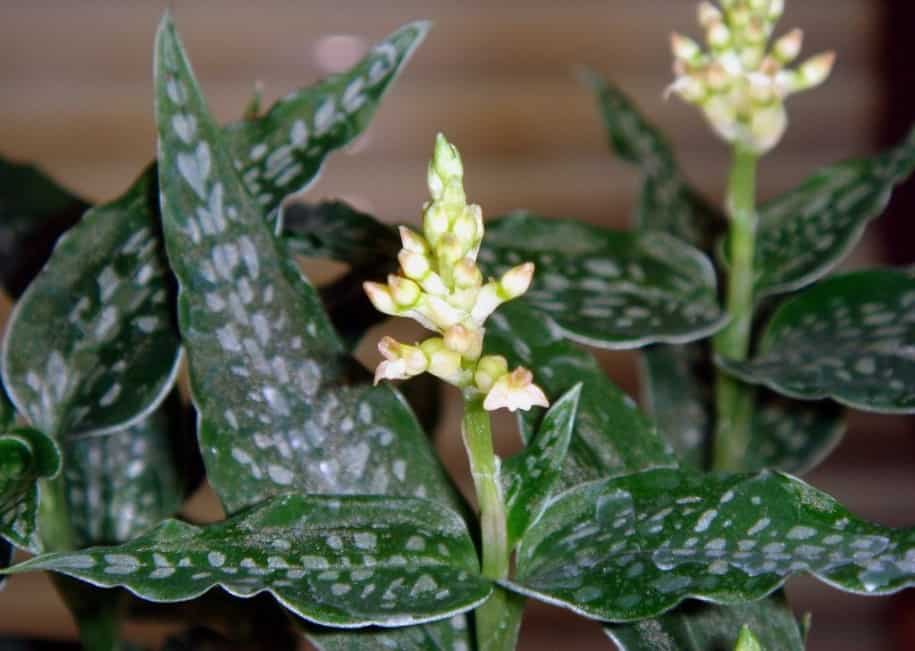

The same should be said about the representatives of the Zeuxine genus growing in southern Africa, Asia, southeastern Australia, one of the species has taken root in the southern United States. Zeuxine orchids live in meadows and forests, are easily recognizable by their wing-flowers, which form compact inflorescences on pubescent brownish peduncles, and reddish-green leaves with a white longitudinal vein.


Description of the variety and origin of Ludisia
In the wild, this type of orchid grows in caves and even trees, attaching its roots to a layer of moss. Most often, an exotic flower is found in the jungles of Southeast Asia, and Indonesia is considered its homeland. This plant is distinguished by thick stems that twist, as if crawling along the adjacent surface. Although the plant produces up to 30 flowers during flowering, its main advantage is its beautiful leaves.
On each creeping stem, five olive or purple leaves, soft to the touch, grow. In addition, their colors are dark green, brown and even almost black. On each leaf 3-4 cm wide, 7 cm long, there are lighter veins. The variety of unusual colors of Ludisia became the basis for the appearance in floriculture of the term - Precious Orchid.
When and how does it bloom?
Ludisia, as a rule, blooms from late autumn and all winter... when all the plants stop blooming, then just ludisia will delight others with its flowering and give unusual beauty. During this period, the orchid needs careful care of it.
TIP: Do not allow water to enter the peduncles, and the soil should not be dry, but not in excess of water.
What if she doesn't?
It happens that ludisia does not bloom... To return flowering to this plant, it is necessary to carry out a number of the following manipulations.
- In the summer, you need to prepare the plant for laying flower buds. The air temperature should be monitored, which should not be more than 29 degrees Celsius. During the day, the temperature should be no higher than 20 degrees, and at night from 15 to 17 degrees Celsius. This will help the ludisia orchid to form new flower buds.
- When ludisia does bloom, then the temperature for it should be made 18 degrees Celsius. This is to ensure that the plant blooms for as long as possible.
Difficulties in growing
With proper care, the ludisia orchid is not susceptible to disease or pest attacks.But if the temperature regime is not observed or the watering is improper, problems arise that lead to a deterioration in the appearance of the flower.


In order to save the plant in time and prevent its death, you need to know about the possible difficulties that arise when growing ludisia, and about the rules for their elimination.
- Mealybug. White lumps appear on the leaves of the orchid, similar to cotton wool. The reason for the appearance is dry air. The plant must be treated with insecticides.
- Whitefly. Lays eggs on the back of the leaf and covers the outside with a sticky white coating. The eggs hatch into larvae that eat the leaves of the flower. First, the plant must be cleaned of pests with a cotton swab dipped in soapy water, then spray the orchid with insecticides.
- Spider mite. It appears in a warm room with dry air and wraps the leaves with white cobwebs. Pests are removed using special insect repellents. To prevent their reappearance, the flower should be moved to a cooler room with a high level of humidity.
- Shield. A sign of its appearance is a sticky coating on the leaves. The cause of the appearance of the pest is also too dry air in the room. The flower needs to be sprayed with special preparations and the humidity level in the room should be increased.
- Sunburn. Appear when direct sunlight hits the leaves of ludisia. The flower needs to be rearranged in partial shade.
- Yellowing and dryness of the tips of the leaves. Appears when placing a flower near batteries or other heat sources. To eliminate the problem, it is necessary to remove the ludisia from the heating devices.
- Root rot. Occurs when over-watering or poor drainage in a flower pot. To combat the disease, the orchid should be transplanted into a new substrate, placing a thick layer of drainage on the bottom of the pot. At the same time, watering must be reduced.
Check out such members of the orchid family as Cambria, Miltonia and Cymbidium.
The ludisia orchid attracts flower growers with its beautiful iridescent leaves, and its cultivation is not difficult even for beginners. Fulfillment of all the described plant care recommendations will allow you to grow a beautiful and blooming ludisia, which will decorate any room.
Transfer
IMPORTANT: The ludisia orchid should be transplanted only if necessary. Should be replanted 3 times a year if the pot becomes too small for roots.
Before replanting a plant, you need to:
- Rinse roots and cut off roots that are rotten or dry.
- Divide the root into pieces and put in separate containers.
- Instead of expanded clay, you can use large pieces of bark. Put sphagnum on top.
- Place the pot in a bright place with a humidity of at least 70-80 percent.
Watch a video about the correct transplant of the ludisia orchid:
Difficulties in caring for ludisia orchid
- With insufficient daily illumination, the plant stretches. Install additional artificial lighting, or change location.
- Low humidity, or too dry an earthen lump, leads to dry leaf tips and dullness.
- Daily temperature drops for a young plant provoke active growth and flowering. For a young flower, this is an additional load, pick the flowers.
- Excessive watering leads to rotting of the root system and the appearance of mold. Ludisia needs to be transplanted with a change of all soil.
- This species does not need strong lighting, and bright light causes the leaves to fade.

